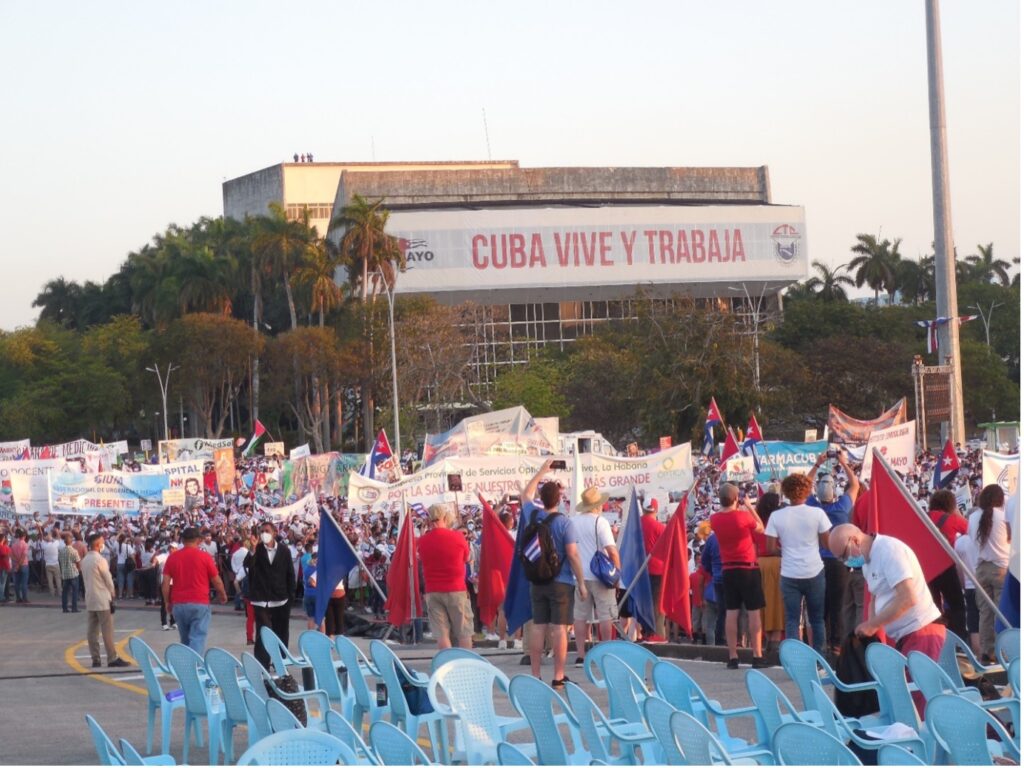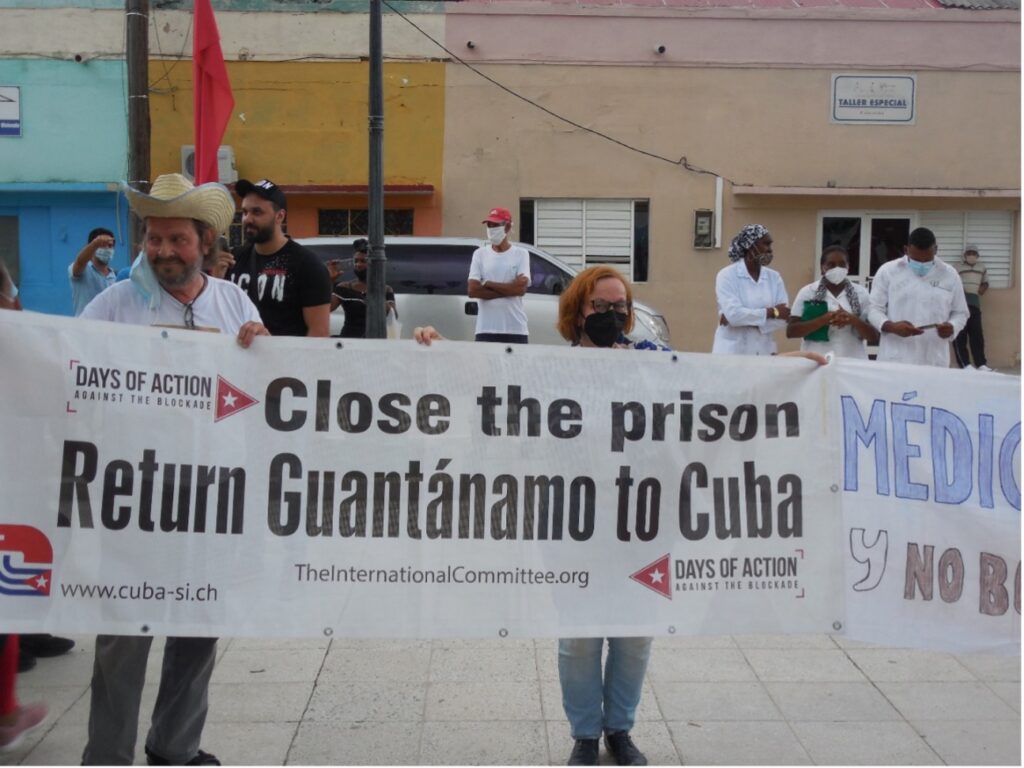The Biden Administration is hosting what it calls “the Summit of the Americas” in Los Angeles the week of June 6-10, but without inviting Cuba, Nicaragua, and Venezuela. Latin American countries are raising a chorus of protest at the exclusion.
First, Mexico’s president Andres Manuel Lopez Obrador announced that he would not attend, quickly followed by presidents Luis Arce of Bolivia and Alejandro Giammattei of Guatemala. Statements by the Caribbean nations and Argentina, Chile, and Honduras also called for an inclusive meeting. The Biden administration’s showpiece of unity is threatening to become a diplomatic and public relations debacle.

In the meantime, people from the Bay Area and around the globe are connecting with those on the island nation. In July of 2020, the San Francisco Board of Supervisors became the first major city in the U.S. to pass a unanimous resolution calling for medical cooperation with Cuba and an end to the 60-plus-year-old US economic blockade. Most cities around the Bay have also passed the Saving Lives resolution, for a total of 48 jurisdictions nationally.
From April 23 to May 8, the two of us, as members of the (San Francisco) Bay Area Cuba Saving Lives Committee, traveled to Cuba with 30 other people on a trip organized by the (US) National Network on Cuba to participate in these three events: May Day Parade, International Solidarity Meeting, and Guantánamo Seminar on Abolishing Foreign Military Bases.
Initially, we stayed at ICAP’s (Institute for the Friendship with the People ICAP) International Camp in the Artemisa Province, where we worked on cooperative farms, mainly weeding around Yucca plants.
Before going to Havana to witness the May Day parade, we also visited a factory that assembles buses as well as attended a block party in one of the towns in the same province. During the block party one of us talked with four youth in their late teens or early 20s about their experiences prior to July 11, 2021.
As a reminder to readers, on 11 July, dozens of Cubans engaged in protests, sometimes involving violence and property destruction, in several cities across Cuba. These protests were reported in US corporate media as being spontaneous.
However, although certainly Cubans were suffering economically, due in large part to the US embargo or blockade as well as the Covid pandemic, some of the protesters’ discourse emphasized critique of Cuba’s political system and calls for regime change. We believe that the strong focus on the political dimension (regime change) stemmed from programs, including the use of social media, which have been financed by the US government to support Cuban artists, journalists, and musicians, who were key organizers of the protests.
When one of us spoke with these youth at the block party on April 30, they explained that they had seen messages on social media—likely ones that had been sponsored indirectly by the US government—calling for people to engage in anti-government demonstrations. However, for them, these messages had the opposite effect—they rejected such calls and instead organized a pro-government (or, as they called it, pro-Revolution) demonstration in their town.
On May 1 we traveled to Havana’s Revolution Plaza to watch the May Day parade, the first held since 2019 because of the pandemic (see photo). The Havana parade, marked by the slogan “Cuba Vive y Trabaja” (Cuba Lives and Works), included 600,000 or more fully masked and highly spirited marchers, while similar parades throughout Cuba counted more than 5 million marchers.
Prominently at front of the parade were healthcare professionals and institutions (i.e., biopharma institutes, hospitals, clinics, and medical schools), reflecting their status as pandemic heroes, having contributed to the protection of the island’s residents and sending 58 brigades to 40 countries to help combat Covid.
Interestingly, and in contrast to Labor Day parades in the US, the groups marching, whether from the health, education, cultural, agricultural, or industrial sectors, did so behind banners or signs indicating the institution for which they worked (rather than banners of their unions or professional organizations).
Then, on May 2 we participated, along with nearly 1,100 people from 60 countries, in the Encuentro Internacional de Solidaridad con Cuba (International Meeting of Solidarity with Cuba), which was held at the Convention Center in Havana (see photo). The meeting consisted of informative speeches made by Cuban ministry and mass organization officials as well as delegates from a range of countries. Following these, those assembled adopted a “Declaration of Solidarity with Cuba,” which read in part:
“Cuba resists and advances in the face of the sustained policy of economic, commercial, and financial blockade, intensified with 243 unilateral coercive measures by the Trump government and [at that point] maintained by the Biden administration, in the midst of a global pandemic. …
We call on the world to mobilize in defense of the [Cuban] Revolution … No more blockade! Long live internationalism and peace!
At the Meeting delegates also adopted a “Declaration on the Summit of the Americas,” which, as noted above, is scheduled to take place 6-10 June in Los Angeles. The Declaration reads in part:
We have learned that the US government, in what amounts to a new discriminatory and politically motivated action, is seeking to exclude Cuba from the 9th Summit of the Americas …
We express our strong opposition to and emphatically condemn any attempt to divide our peoples, as implied by the exclusion of Cuba or any other Latin American sister nation from the summit mentioned. …
Those attending the Meeting also promoted two other summits that are scheduled in June to counteract the Organization of American States-organized Summit of the Americas: a) the People’s Summit for Democracy being organized by unionists, activists, grassroots organizations and progressive people of the Americas also in Los Angeles, June 8-10; and b) the Workers Summit of the Americas, scheduled to take place in Tijuana, Mexico, June 10-12.
We should mention that although 23 members of Cuban civil society were invited to the People’s Summit, the Biden administration has thus far denied their visas. The Worker’s Summit was purposefully organized to include representatives from the countries (Cuba, Nicaragua, and Venezuela) that have been excluded from participation in the Summit of the Americas but are being welcomed by the Mexican government.
Subsequently, we traveled to the city of Guantánamo to attend the “7th International Seminar for Peace and the Abolition of Foreign Military Bases,” which was organized by the World Council for Peace during May 4-5.
The seminar, which was attended by 84 delegates and guests from Argentina, Germany, Barbados, Brazil, Bolivia, Canada, Chile, Colombia, Cuba, Denmark, United States, Spain, the Philippines, Greece, Guyana, Mexico, United Kingdom, Puerto Rico, Palestine, Syria, Sierra Leone, Sweden, Switzerland, Venezuela and Norway, included presentations by Cuban government and mass organization officials as well as delegates from several other countries. We learned about the history of the U.S. military base (and prison) in Guantánamo, which was established in 1898 and has been used to launch US military actions against other countries, including the Dominican Republic (1923), Haiti (1914 and 1915), Honduras (1923), Mexico (1911 and 1915), and Nicaragua (1923).
The Seminar concluded with adopting a “Final Declaration,” which read in part:
[We], the fighters for peace, gathered in Guantánamo, are committed to: …
Strengthen the demand for the closure of all foreign military bases, facilities and enclaves and the immediate withdrawal of foreign occupation troops in those countries where they have been deployed …
Continue to demand the return of the territory illegally occupied by the US Guantánamo Naval Base to its legitimate owner.
Denounce the actions against the environment and the health of the populations where foreign military bases are located.
After the Seminar we spent the afternoon and evening in the municipality of Caimanera, which is the population center located closest to the U.S. military base at Guantánamo Bay. This is the town that before the Cuban Revolution in 1959 served was the site for recreation for US military personnel (i.e., drinking and prostitution) and was the source of most of the base’s civilian workforce.

We were treated to a block party and cultural performances. The people of Caimanera still suffer due to limitations on their movement in THEIR province and restrictions on where they can fish in Guantánamo Bay. The messages we received from the people in Caimanera was that Americans and others should come to visit Guantánamo (see photo of poster) but also people should continue to struggle to close the US military base and prison (see photo of banner being held by medical personnel).
We hope that our sharing of some of our experiences during this recent trip to Cuba has been useful to readers. We encourage everyone to find ways to go to Cuba to learn directly for themselves.



